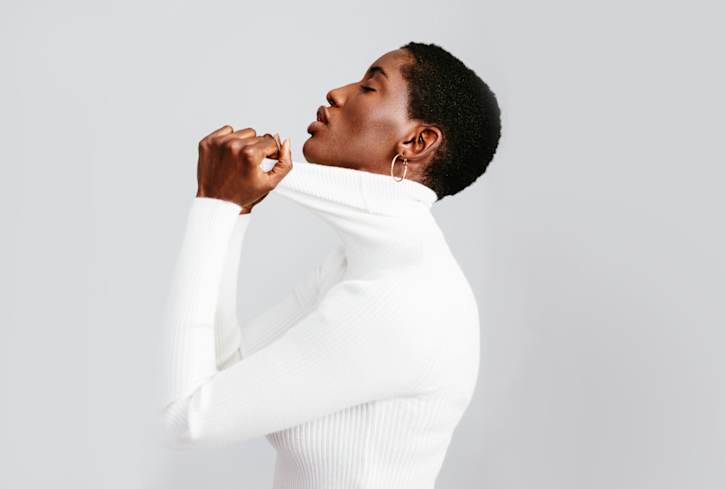Advertisement
Why Seeking More Glimmers Is A Recipe For A Happier, Calmer, More Connected Life

Many close friends often tell me I'm good at entertaining myself. I had never really thought much about my practice of noticing sunsets, seeking out art, and hugging random animals, for instance, apart from the fact that I enjoy it and it makes my life better.
It was only later on that someone put a name to these micro-moments of joy: glimmers.
What are glimmers?
We spend so much time analyzing and obsessing over the bad stuff in our lives and our pasts, which can lead our brains to notice too much negativity. Or, of course, for our nervous systems to continuously be re-triggered. So it makes absolute sense to use our mental energy to, instead, look for the good stuff that nourishes and heals us—and that's what glimmers are all about.
The term "glimmer" was first introduced by social worker Deb Dana in her book, The Polyvagal Theory In Therapy: Engaging The Rhythm Of Regulation. They're micro-moments that make us feel happier, hopeful, safe, and connected. And the best thing is, we can easily access them by looking for them.
Seeking out glimmers is a particularly helpful practice in the neurodiverse community, with occupational therapist Bec Secombes describing them as "a satisfying sensory delight that fills someone with fervent ecstasy."
Populations like the highly sensitive and neurodiverse have a threat-response learning system that is more sensitive and attuned to threats, but this very same nervous system also adapts quickly to cues and environments that are safe and supportive. In other words, the glimmer detectors are like metal detectors on steroids—they are cranked up and ever ready to revel in the beauty of life.
Why should you find glimmers?
Put simply, glimmers are great for your mental health. On a bad day or when you're moving through a more difficult chapter, glimmers can offer a reset button. And from there, a healthier headspace gives you more energy and inspiration to do the things that might otherwise feel hard.
This isn’t to say you should lie to yourself about how you’re feeling or pretend a difficult situation doesn’t need work. Rather, sometimes we 're in a headspace where our brains are biased towards remembering and noticing things associated with danger, losses, or anything else negative. And that puts us in a position where we fail to notice the good things, much less interact with the world in a way that creates more positivity.
For instance, when you are feeling isolated, you’re more likely to interpret benign facial expressions as threatening, and that makes you likelier to react to people in hostile way, and vice versa, reinforcing your perception that the world is a dangerous place.
To understand glimmers better, it is useful to see the different nervous system states we experience as a ladder:
- At the bottom is the freeze state. We are paralyzed or immobilized here and the dorsal vagal nerve circuit is activated. We feel things like worthlessness, hopeless, or numbness. We might cry, isolate ourselves, or be dissociated. Our skin feels cold, our posture is slouched, and we do very little.
- A step up is the fight or flight state. The sympathetic nerve circuit is activated. We can feel things like motivation, anger, or anxiety; We engage in actions like running away, attempts to confront, or physical movement; Our muscles are braced for action and our heart rate is higher.
- At the top of the top of the ladder is where we feel safe and socially engaged. The parasympathetic nervous system, specifically the ventral vagus nerve circuit, is activated. We can feel secure, centered and connected; Do things like creative thinking, problem solving, or connecting with the world around us; Our hearts are calm and we have an open posture. In this state, our body also enters homeostasis, where it regulates itself.
According to Secombe, glimmers are useful because they
- Put us in an anchored state, where we go from survival to thriving mode.
- Help us feel seen, heard, understood and validated, from which we can connect with others empathetically.
- Support us to feel safe, cozy and secure, and so we can explore possibilities, entering a comfortable learning zone.
Are micro-moments of goodness that help our bodies to discharge the buildup of cortisol from previously-stressful situations, so we can return to a calm state where we also feel included.
Or when life is okay or good, why not make it better by tuning into all the amazing things that are already around. In this case, it’s really about living what I call #EverydayAmazing in my book, or the Italian notion of La Dolce Vita— life is beautiful.
How to find more glimmers
In Aristotle’s treatise On The Soul, the human being comes alive through the five senses—and I couldn’t agree more. Instead of having to experiment from scratch, one thing we can do to find more glimmers is to create a repository based on your existing muscle memory.
Try word association
For any of the following words (where relevant), jot down where you experience each of these feelings in your body, and what happened when you felt that way. This could be in a social context, or when you are by yourself.
- Happy
- Awe
- Hopeful
- Connected
- Joy
- Glee
- Peace
- Cared for
- Connected
For instance, I experience connection as a warm sensation in my heart that radiates through my chest. And that happens when a loved one does something thoughtful, when I see a cat or dog walking by, or when I think of times these happened.
Too complicated? Try jotting down what accidentally makes your heart smile.
Look for your unique glimmers all around you
Secombe also gives other examples of glimmers, including the sound of rain, a cat purring, damp springy moss, shiny bubbles, new leaves growing on plants, watching fish, and rainbows.
For me, these everyday glimmers come especially unexpectedly from spotting a planet in the night or dawn sky, the beautiful scent of cooking or nature, a butterfly flying into my garden, discovering beautiful art, or even the texture of trees.
Tap into your inner role model
Sometimes, when we're in the frozen state, it's difficult to look for glimmers. Frozen isn’t just about hiding in bed or on your sofa—sometimes it looks like rampant procrastinating on your phone instead of doing your tasks because everything feels overwhelming.
We often can’t even be motivated to seek glimmers out, much less feel we deserve them, when we're in this place. But in these instances, reflect upon which of the above emotions and their associated glimmers help move you up the polyvagal ladder.
A common one would be imagining what a kind role model would say to us, even if we couldn’t be kind to ourselves, because they would still be kind to you. And when your nervous system feels safe, it is then easier to experience glimmers.
For this, I recommend a protocol:
- Acknowledge what you’re feeling without judging yourself, whether it’s a singular or mixed emotion. Simply name it as a fact of the moment.
- Take a deep breath in through your nose, imagining you are inflating your belly with air; hold for 4 counts, then exhale everything out for 7. Repeat three times. This way, you "reset" your brain away from fear mode towards a more centered state, and also activate your parasympathetic nervous system.
- Visualize what your kind role model would say to you and breathe into that feeling.
- Go seek glimmers that you’ve already listed out.
Go on glimmer expeditions
One thing I’ve always loved is to go on a "glimmer expedition" by scheduling awe walks. And you can do them in urban settings too—I do them in bookstores and Sephora at times.
For me, using a camera is a good way to focus my mind, and then if I choose to share photos online, it becomes a way of reflecting and a gratitude journal. This makes it feel like the HIIT version of glimmers, where the effects last for a long time, and can easily be reawakened.
When I take my awe walks with friends and we share and repost our pictures, I’ve found that this also creates a stronger connection with glimmers and with my friends.
FAQs:
What are glimmers and triggers?
Glimmers are internal or external cues that help us feel joy, safety or connection. Triggers are danger cues that make us feel threatened, leading us to fight, run away, freeze or fawn.
What is the glimmer polyvagal theory?
The glimmer polyvagal theory tells us that we can seek out experiences that help us feel safe, happier or connected. Instead of looking out for triggers, we can also help our healing and mental health via glimmers.
What triggers the dorsal vagal nerve?
Any sensory memory we associate with danger that leads us to freeze triggers the dorsal vagal nerve. This could range from smells linked to a past dangerous/abusive event, to certain details in furniture. When triggered, the timekeeper in our brain thinks that now is then, and we react that way.
The takeaway
As someone with ADHD, I get bored easily. But upon reflecting, it surprised me how I have never been bored of my glimmers for years. Catching the sunset, looking at planets, watching new leaves unfurl—the simplest things that would theoretically bore a brain that needs constant novel stimulation—continue to heal, nourish, and elevate me.
And it is with firsthand benefiting from an accidental longstanding practicing of going on "glimmer expeditions" that I encourage you to gift yourself this practice too.


















